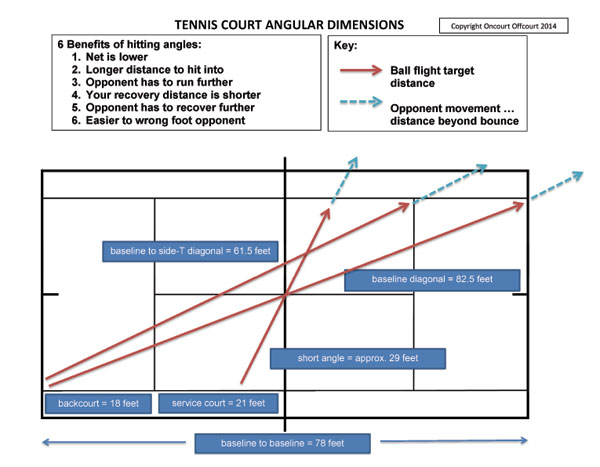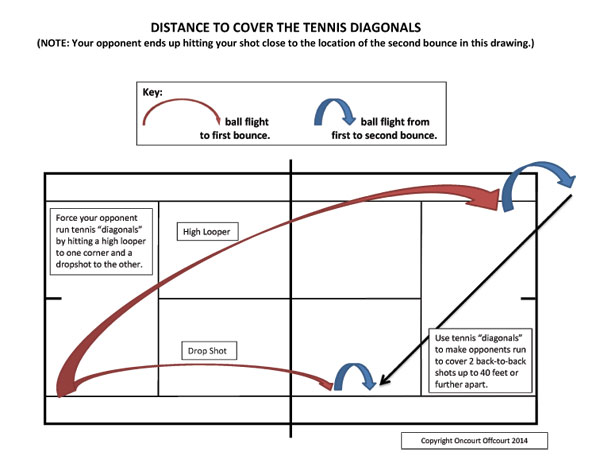|
TennisOne Lessons

Tennis Court Geometry Made Simple
The Diagonal Theory!
Joe Dinoffer
USPTA and PTR Master Professional
President, www.OncourtOffcourt.com
If you were like me in school, you sat through geometry and other subjects, wondering why you had to learn certain things and, specifically, how they would be relevant in your life. If my geometry teacher had just related shapes and calculations to tennis offense, defense, targeting, positioning, and recovery, I probably would have paid much closer attention!
Increasing Your Target Length
Some ball sports reward you for hitting further, but in tennis, while hitting deeper in the court is good, the length boundaries are clear and unforgiving. In baseball, there is no limit on the distance a home run is hit. In golf, you can overshoot the green and still get a chance to hit the ball “backwards” to score. In football, there is no penalty for kicking field goals that fly well past the goal posts. And, in hockey or soccer, you can hit as hard as you want into the goal. In tennis, just about anytime you get to expand the length or width of the court to hit into a larger target is clearly a good thing.
What’s this tactical concept called? Hitting on the diagonal or crosscourt. Watch the video clip above for some tips on how to develop these crosscourt groundstroke skills. In geometry, that distance would be the hypotenuse of a triangle. The chart below shows how the actual/virtual court target grows in length when you hit crosscourt.

The Diagonal Theory — Four Applications
- Court Length — The first tactical benefit of using the court diagonals is about increasing your target size and hitting over the lower part of the net, etc. (See chart in this article.)
- Shorten Recovery Distance — The issue of efficient recovery could be the topic of a separate article, but in short remember this: Seldom recover to the middle! In groundstroke exchanges, recover 1-2 strides from the middle to the opposite side from wherever your opponent strikes the ball. This will help you cover their potential angles.
- Run Your Opponent — The third concept when hitting along court diagonals is to get your opponent to run further for a single specific shot, to pull them out of position to open up the court. See the court diagram below showing where your opponent would have to run to retrieve various types of crosscourt forehands.

- Back-to-Back Diagonals — The fourth concept of “The Diagonal Theory” is to use the diagonals on back-to-back shots to make your opponent take extra steps on two shots in a row. Whether it’s a hot day or you’re having a long match, making your opponent run further is one of the best tactics you can utilize. A fatigued player struggles more to get into position and balanced. And, we all know that when we are out of position and off-balance, we make more errors. See the court diagram below to make your opponent run 40 feet to get one single shot!

Three Times to Hit Down the Line
- Exploit a very obvious weakness — If your opponent has a decisively weaker groundstroke “wing,” avoid the strength and hit to the weakness as much as possible. Think of how Nadal plays Federer.
- Get to your favorite crosscourt pattern — All players have a more favored groundstroke side. If you find yourself in a crosscourt rally that forces you to hit off your weaker “wing,” then just hit down the line. Chances are your opponent will hit that ball crosscourt to the open court and you will now be hitting crosscourt groundstrokes with your stronger groundstroke, rather than your relatively weaker one.
- Wrong foot your opponent — Another time to hit down the line is when you have been repeating a regular crosscourt pattern. Inevitably, your opponent will start leaning towards receiving the next crosscourt shot and that is when you can wrong-foot even the best moving opponent. This tactic can win some points, but also keeps your opponent guessing.
Summary
In this article we have shared the primary “big picture” reasons to regularly hit groundstrokes in crosscourt patterns. Let’s finish with the icing on the cake; namely, with a couple of the more subtle but nevertheless still important additional reasons.
First, hitting crosscourt with topspin groundstrokes is easier for most players as compared to down the line, considering that the swing is more circular.
And, second, your ball can land further from the singles sideline yet still be very effective, since the ball is moving crosscourt and “away” from your opponent!
Your comments are welcome. Let us know what you think about Joe Dinoffer's article by emailing us here at TennisOne.
|
|


